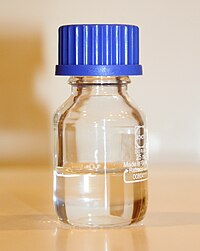
Photo from wikipedia
Abstract It is important to understand the influence of processing conditions to design a desirable food product. The microstructure and water sorption capacity of three types of fried potato chips… Click to show full abstract
Abstract It is important to understand the influence of processing conditions to design a desirable food product. The microstructure and water sorption capacity of three types of fried potato chips were evaluated in order to gain an understanding of how the different processing conditions impacted their structures and further, their textures and shelf life. Pore structures were quantified and analyzed using both the capillary penetration technique of a mercury porosimeter and the imaging technique of X-ray computed tomography (μCT). Additionally, the water vapor sorption isotherm was quantified using a Pro Umid SPSx-1μ system. The results indicated that ridged potato chips (RPC) showed the highest porosity (50.78 ± 3.02%), followed by flat potato chips (FPC) (41.15 ± 3.56%), and batch cooked potato chips (BCPC) (32.58 ± 4.21%). A similar trend was exhibited in the data obtained from X-ray μCT. The solids distribution in RPC, FPC, and BCPC was 21.56 ± 7.97%, 24.87 ± 5.83%, and 34.28 ± 9.49%, respectively, determined by μCT. μCT cross-section images displayed a highly porous microstructure in FPC, while RPC appeared to have thicker walls and larger cells than the others. The data suggested that the critical water activity (a w ) of the three types of potato chips ranged from 0.70 to 0.85. At higher a w (above 0.85), RPC displayed the highest moisture absorption capacity, followed by FPC, and BCPC. The results also showed that a higher percentage of porosity is followed by higher moisture content in the potato chips. The findings propose that water vapor sorption of the three types of potato chip was governed by the Flory-Huggins model. In addition, the oil significantly blocked water sorption in the samples ( p
Journal Title: Journal of Food Engineering
Year Published: 2017
Link to full text (if available)
Share on Social Media: Sign Up to like & get
recommendations!